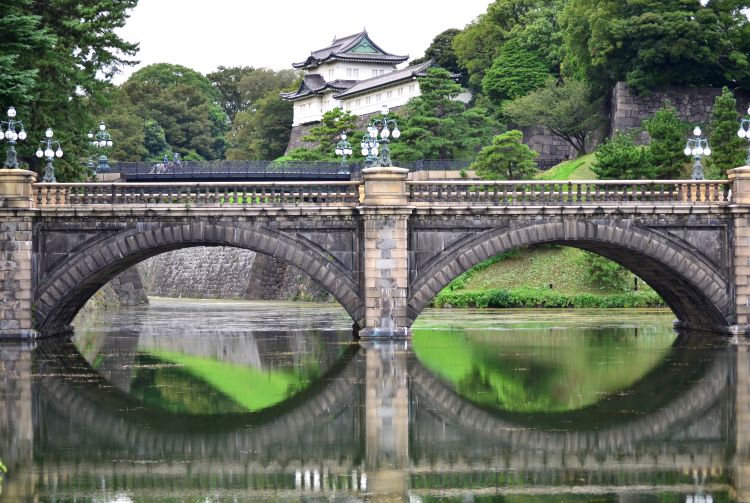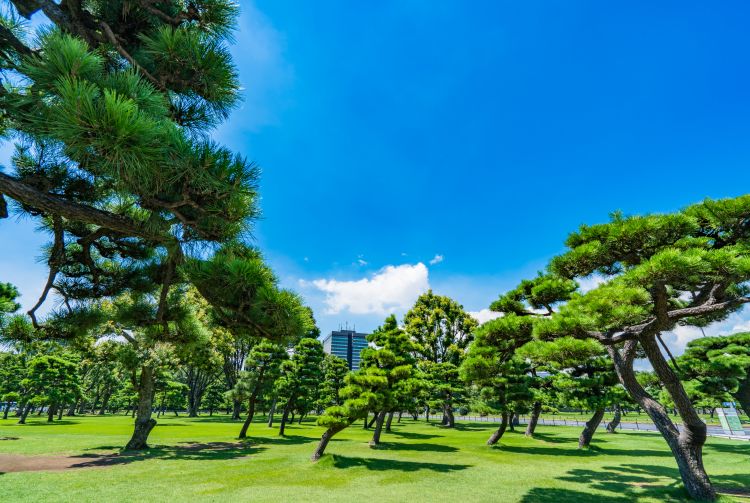Garden strolls, art treasures and tours within an imperial castle's grounds
Home to the emperor of Japan, the Imperial Palace is built upon the site of Edo Castle, home to the Shogun before 1868. Protected by wide moats and thick walls and surrounded by meticulously kept gardens, the grounds offer a peaceful green contrast to the steel and glass of downtown Tokyo's modern office buildings.
Runners, cyclists and strolling couples and families frequent the outer palace grounds. There are tours of the grounds as well, and you can get in to see the imperial art collection for free.
Don't Miss
- Tours of the inner palace grounds—the only way to see the Emperor's home
- The seasonal flowers and castle ruins in the East Garden
- Taking advantage of the free admission to the Imperial art collection
How to Get There
The outer gardens of the Imperial Palace are extensive, and can be reached from several different gates and metro stations.
The Ote-mon gate is a popular option, since it was the main gate of Edo Castle. The gate is a five-minute walk from the Otemachi subway station, or a 15-minute walk from Tokyo Station.
The Hirakawamon and Kita-hanebashimon gates are located closer to Kitanomaru Park; both are a five-minute walk from Takebashi Station on the Tozai metro line.

Tokyo's own Central Park
Although much smaller than in its heyday, the grounds of the Imperial Palace Gardens are around 115 hectares and are divided into four main parts. Three are open to visitors — the Kokyo Gaien National Garden , Imperial Palace East Garden and Kitanomaru Park . The inner palace area can only be visited on special tours, which depart from the Kikyo-mon Gate.
Japanese gardens and woodlands surrounded by skyscrapers
Each of the three gardens has its own character. Kokyo Gaien National Garden is the most urban, offering views of the towering skyscrapers of busy Marunouchi that contrast with the Meiji era (1868-1912) Nijubashi bridge and black pines.

Housing Ninomaru—an Edo period (1603-1867) garden—the East Garden are a delightful secret park filled with blooming flowers, ancient walls and the elegant Suwano teahouse. A few guardhouses from the period have also survived.

A view of the Suwano teahouse
Kitanomaru Park is full of little brooks. The park is home to Nippon Budokan hall —a large event space hosting everything from judo to rock and roll—as well as the Science Museum and The National Museum of Modern Art, Tokyo —a museum you can enjoy historical masterpieces to contemporary artworks.
Sights beyond the palace
Its central location means there are lots of cultural sights and things to do around the perimeter of the palace. Near Tokyo Station are the Idemitsu Museum , Tokyo International Forum (which also houses the Mitsuo Aida Museum and the elegant shops of Marunouchi.

In the northwest corner of the Kokyo Gaien National Garden is Chidori-ga-fuchi, where you can rent a boat and view the castle walls from a duck's-eye view. A short walk from Kitanomaru Park there are exhibits about life in Japan during WWII and after the war at the Showakan, and huge torii gates of Yasukuni Shrine.
To the west, you can find the National Diet Building and the National Theatre , which hosts traditional kabuki, noh, and other performances. Next to the theater is the Traditional Performing Arts Information Centre , full of costumes, props and archive footage.

























































